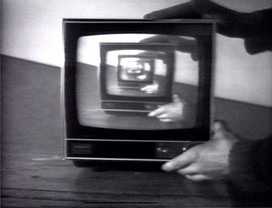
Stephen Partridge Still from Monitor
This selection is drawn from the DVD publication Rewind + Play: An Anthology of Early British Video Art published in 2009 by LUX, the artists' moving image agency, in association with REWIND: Artists' video in the 70s and 80s.
Projection
In Two Minds (two-screen version), Kevin Atherton (1978, 25 min)
Circling, Peter Donebauer (1975, 12 min)
Kensington Gore, Catherine Elwes (1981, 15 min)
Time Spent, Judith Goddard (1981, 12 min)
Clapping Songs, Tina Keane (1979, 6 min)
Monitor, Stephen Partridge (1975, 6 min)
Monitor
TV Interruptions (7 TV Pieces), David Hall (1971, 23 min)
Vanitas, Tamara Krikorian (1977, 8 min)
REWIND + PLAY presents a selection of key works from the first decade of artists' video practice in the UK. Work of that period is characterised by self-reflexivity in the medium, by an investigation of the limits of the then-new technology and by opposition to the dominant video form of the time: broadcast television. With the notable exception of David Hall's TV Interruptions, first shown unannounced on Scottish television in 1971, the works in this selection were made for gallery exhibition. Before the advent of video projectors, work was produced and displayed using TV monitors, and the 'box' was recognised by some artists as an inevitable sculptural context that influenced the making and reading of their work. This was especially so in works which referenced television or were actually made for broadcast. Tamara Krikorian's Vanitas 1977 and David Hall's TV Interruptions 1971 are screened on a TV monitor for this reason.
Most of the work was produced or shown around two key exhibitions of the period – The Video Show at the Serpentine Gallery in May 1975 and a video installation show at the Tate Gallery in 1976 – and disseminated through the artist-run video distributor London Video Arts which was established in 1976.
